13 Jul A Look at the First Plants of the Cory Brown Memorial Dye Garden
Welcome to the new Folk...

Welcome to the new Folk...
Have you always been drawn...
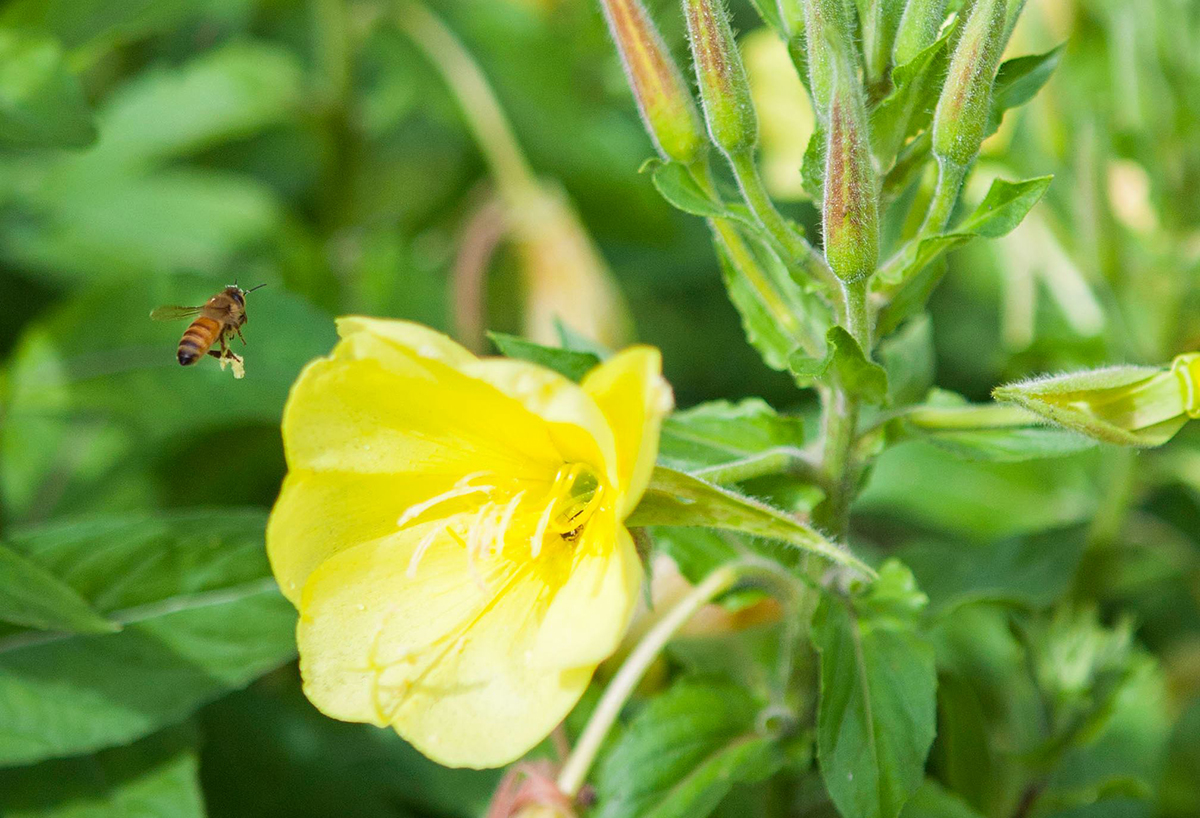 The morning after the bloom, a bee visits the Tina James Magic Primrose.[/caption]
[caption id="attachment_16955" align="alignright" width="333"]
The morning after the bloom, a bee visits the Tina James Magic Primrose.[/caption]
[caption id="attachment_16955" align="alignright" width="333"] The fresh Evening Primrose blooms at dusk[/caption]
Our Tina James Magic Primrose plants have been putting on quite a show for the past few weeks at dusk in the Vegetable Garden and behind the Painting Studio. The tightly wound yellow blooms dramatically open as night falls (around 9 p.m.). Before the show starts, visitors walk around the plant to see if they can guess which bloom will lead be the leading note of the overture. Excitement and anticipation is high and it is easy to feel giddy, like a little kid again.
The sepals (the green outside of the flower) peel down the flower and the tightly wound yellow trumpet begins to relax and open. Within seconds, before your very eyes, the blossom opens fully and settles into a large bright yellow flower with a delicate, sweet smell. It's is like watching time-elapsed photography in real time; it's just incredible. Each bloom only lasts through the night until mid-morning of the next day, attracting pollinators like bumble bees and butterflies during the morning and large humming bird-sized lunar moths at night.
The fresh Evening Primrose blooms at dusk[/caption]
Our Tina James Magic Primrose plants have been putting on quite a show for the past few weeks at dusk in the Vegetable Garden and behind the Painting Studio. The tightly wound yellow blooms dramatically open as night falls (around 9 p.m.). Before the show starts, visitors walk around the plant to see if they can guess which bloom will lead be the leading note of the overture. Excitement and anticipation is high and it is easy to feel giddy, like a little kid again.
The sepals (the green outside of the flower) peel down the flower and the tightly wound yellow trumpet begins to relax and open. Within seconds, before your very eyes, the blossom opens fully and settles into a large bright yellow flower with a delicate, sweet smell. It's is like watching time-elapsed photography in real time; it's just incredible. Each bloom only lasts through the night until mid-morning of the next day, attracting pollinators like bumble bees and butterflies during the morning and large humming bird-sized lunar moths at night.
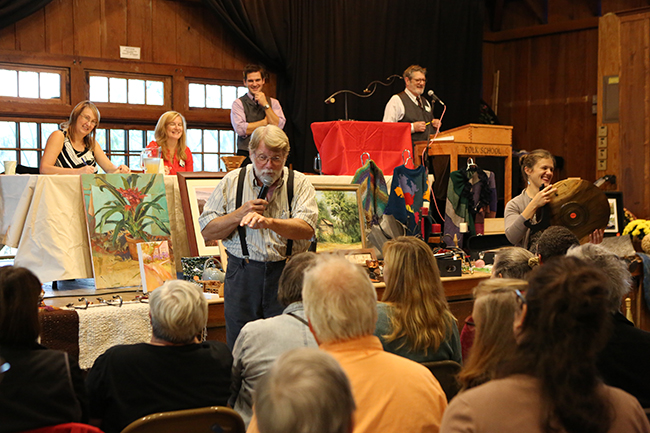 I first met Tim Ryan on a misty morning in the Folk School Garden when I was a Work/Study in 2011. My immediate impression of him was that he was a very witty & interesting character with lots of fantastic stories. Tim is involved in the Folk School in so many different ways. He recently handed over his position as Resident Artist in Gardening and Homesteading to Karen Hurtubise and he will be co-auctioning (with Bob Grove) the Gala & Benefit Auction on June 11, 2016. I thought this would be a good moment to sit down and learn a little bit about Tim the gardener, auctioneer, medicine showman, raconteur, kettle cooker, blacksmith, instructor, former Folk School Board member, bibliophile, and storyteller, that is Tim Ryan. We recently sat down over lunch to talk about many things. Enjoy our interview!
CP: When did you first come to the Folk School?
[caption id="attachment_15023" align="alignright" width="289"]
I first met Tim Ryan on a misty morning in the Folk School Garden when I was a Work/Study in 2011. My immediate impression of him was that he was a very witty & interesting character with lots of fantastic stories. Tim is involved in the Folk School in so many different ways. He recently handed over his position as Resident Artist in Gardening and Homesteading to Karen Hurtubise and he will be co-auctioning (with Bob Grove) the Gala & Benefit Auction on June 11, 2016. I thought this would be a good moment to sit down and learn a little bit about Tim the gardener, auctioneer, medicine showman, raconteur, kettle cooker, blacksmith, instructor, former Folk School Board member, bibliophile, and storyteller, that is Tim Ryan. We recently sat down over lunch to talk about many things. Enjoy our interview!
CP: When did you first come to the Folk School?
[caption id="attachment_15023" align="alignright" width="289"]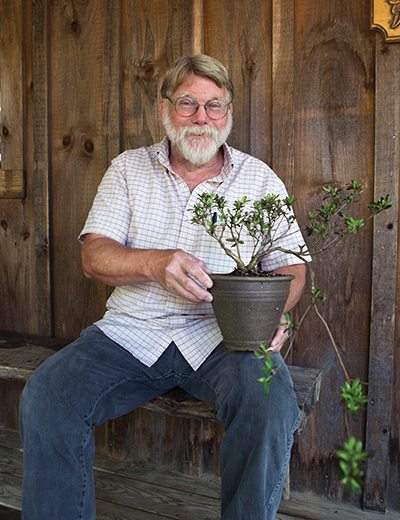 Tim Ryan with a bonsai tree[/caption]
TR: I had gotten divorced and it killed me. This was 26 years ago. I was depressed and blue and three things saved me: my Blacksmithing buddies, Al-Anon, and having a daughter.
At one of the Appalachian Area Chapter Blacksmith Meetings in Mt. Juliet TN, they were having a raffle and the winner would get a free class at the Folk School. Well I don’t usually enter raffles, but my Blacksmithing buddies convinced me to enter and I won. I think they set it up because I was depressed and they knew I needed something else to focus on. It worked because I won the raffle in March or April and the class wasn’t until October, so all summer long I worked hard to become a better blacksmith, worthy of the class at the Folk School.
In the fall of 1990, I used my scholarship to take a 2-week Blacksmithing class at the Folk School with Francis Whitaker, which I was by no means near prepared for, naturally.
[caption id="attachment_15036" align="aligncenter" width="630"]
Tim Ryan with a bonsai tree[/caption]
TR: I had gotten divorced and it killed me. This was 26 years ago. I was depressed and blue and three things saved me: my Blacksmithing buddies, Al-Anon, and having a daughter.
At one of the Appalachian Area Chapter Blacksmith Meetings in Mt. Juliet TN, they were having a raffle and the winner would get a free class at the Folk School. Well I don’t usually enter raffles, but my Blacksmithing buddies convinced me to enter and I won. I think they set it up because I was depressed and they knew I needed something else to focus on. It worked because I won the raffle in March or April and the class wasn’t until October, so all summer long I worked hard to become a better blacksmith, worthy of the class at the Folk School.
In the fall of 1990, I used my scholarship to take a 2-week Blacksmithing class at the Folk School with Francis Whitaker, which I was by no means near prepared for, naturally.
[caption id="attachment_15036" align="aligncenter" width="630"]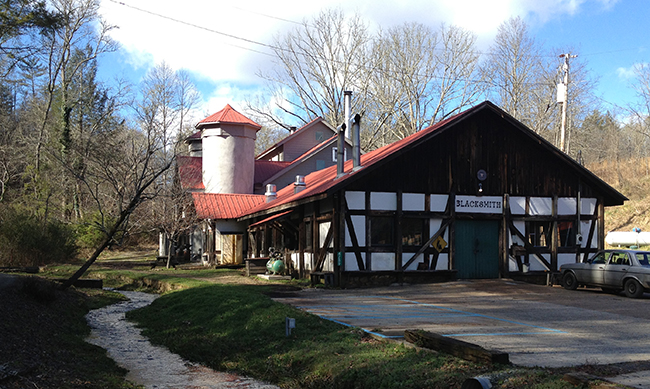 The Folk School Blacksmith Shop (Original Francis Whitaker Shop in the foreground, the new Clay Spencer Shop in the background)[/caption]
The Folk School Blacksmith Shop (Original Francis Whitaker Shop in the foreground, the new Clay Spencer Shop in the background)[/caption]
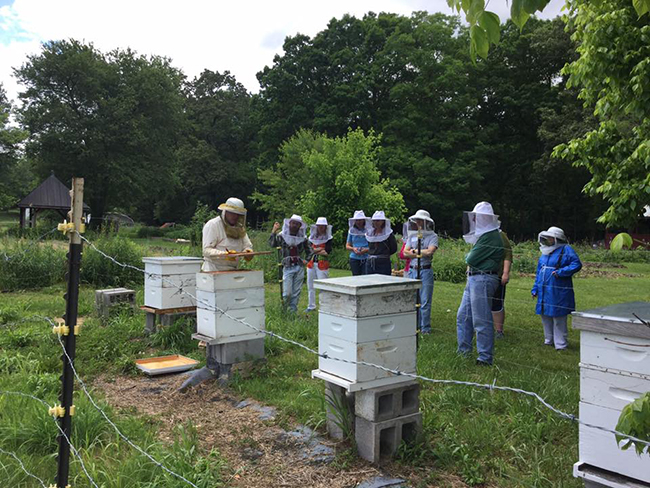 John Clarke in the Folk School bee yard, showing the class the old bee hives, plus two brand new Russian bee colonies installed from the Beekeeping Class three weeks ago with Virginia Webb. Russian bees seem to be more varrora mite resistant than our beloved Italian honey bees.
John Clarke in the Folk School bee yard, showing the class the old bee hives, plus two brand new Russian bee colonies installed from the Beekeeping Class three weeks ago with Virginia Webb. Russian bees seem to be more varrora mite resistant than our beloved Italian honey bees.
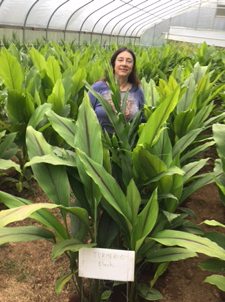 Standing in a new Black Turmeric variety in the hoophouse.[/caption]
In 1981, my husband John Clarke and I traveled cross country from Oregon to Brasstown in our un-aircondtioned '66 blue Dodge Dart we called “Grandma.” We were coming to the six month John C. Campbell Folk School Homesteading program. John had already been to the Folk School to learn woodcarving with Jack Hall in 1977 and had returned every fall (1978-80) when the blacksmiths and quilters were there.
To our surprise, the Homesteading program had gone defunct, so instead we became Work/Study students and attended a two week furniture making class with Dana Hatheway. We made a gorgeous poplar desk we still use and love today.
Standing in a new Black Turmeric variety in the hoophouse.[/caption]
In 1981, my husband John Clarke and I traveled cross country from Oregon to Brasstown in our un-aircondtioned '66 blue Dodge Dart we called “Grandma.” We were coming to the six month John C. Campbell Folk School Homesteading program. John had already been to the Folk School to learn woodcarving with Jack Hall in 1977 and had returned every fall (1978-80) when the blacksmiths and quilters were there.
To our surprise, the Homesteading program had gone defunct, so instead we became Work/Study students and attended a two week furniture making class with Dana Hatheway. We made a gorgeous poplar desk we still use and love today.
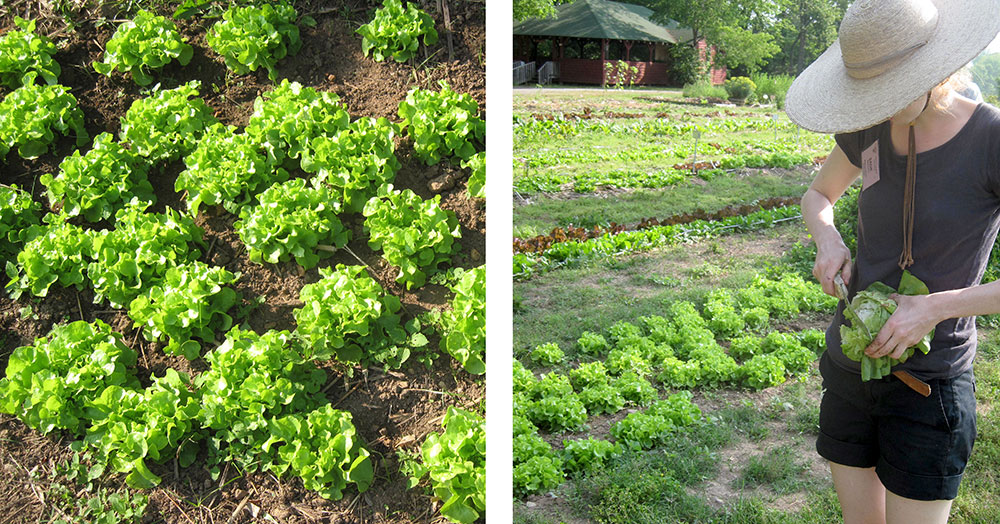 Lettuce in the Vegetable Garden is harvested by Work/Studies and brought to the Dining Hall[/caption]
Lettuce in the Vegetable Garden is harvested by Work/Studies and brought to the Dining Hall[/caption]
[caption id="attachment_7303" align="alignleft" width="291"]
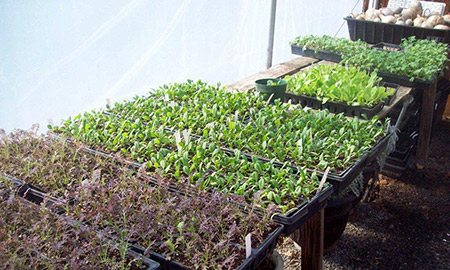 Kale, Spinach, and Lettuce transfer seed starts in the Folk School Green House[/caption]
Kale, Spinach, and Lettuce transfer seed starts in the Folk School Green House[/caption]
The Folk School’s vegetable garden provides organic, seasonal produce for our Dining Hall and our Cooking Studio. This time of the year, lettuce, kale, mustard greens, and collards transfer from their green house tray location to the earth. Volunteer Coordinator/Gardener Joe Baumgartner and the Work/Study crew have been busy tending to the seed starts and prepping beds since January.
[caption id="attachment_8227" align="alignright" width="206"] Salad with Kale and lettuce from the Vegetable Garden[/caption]
Salad with Kale and lettuce from the Vegetable Garden[/caption]
Much of what is planted in the garden supplies and supplements the salad bowl and vegetable dishes in the Dining Hall. When you enter the Dining Hall check out the sign next to the menu board which details exactly what the Dining Hall is using from the garden each week. Next time you enjoy salad or veggies at lunch or dinner in the Dining Hall, take a post-meal stroll over to the Vegetable Garden to see what's growing.
[caption id="attachment_7626" align="aligncenter" width="450"]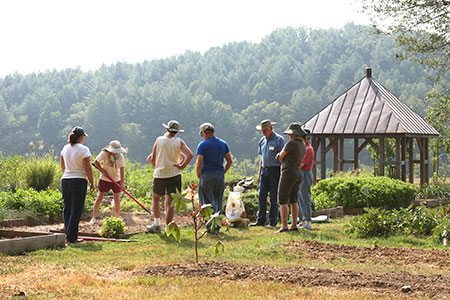 Frances Juhlin teaches about heirloom vegetables in the Folk School Garden.[/caption]
Frances Juhlin teaches about heirloom vegetables in the Folk School Garden.[/caption]
It’s Valentine’s Day here at the Folk School. I caught up with some friends and classmates this week to hear more about what folks are doing to mark the occasion.
Karen and Paul
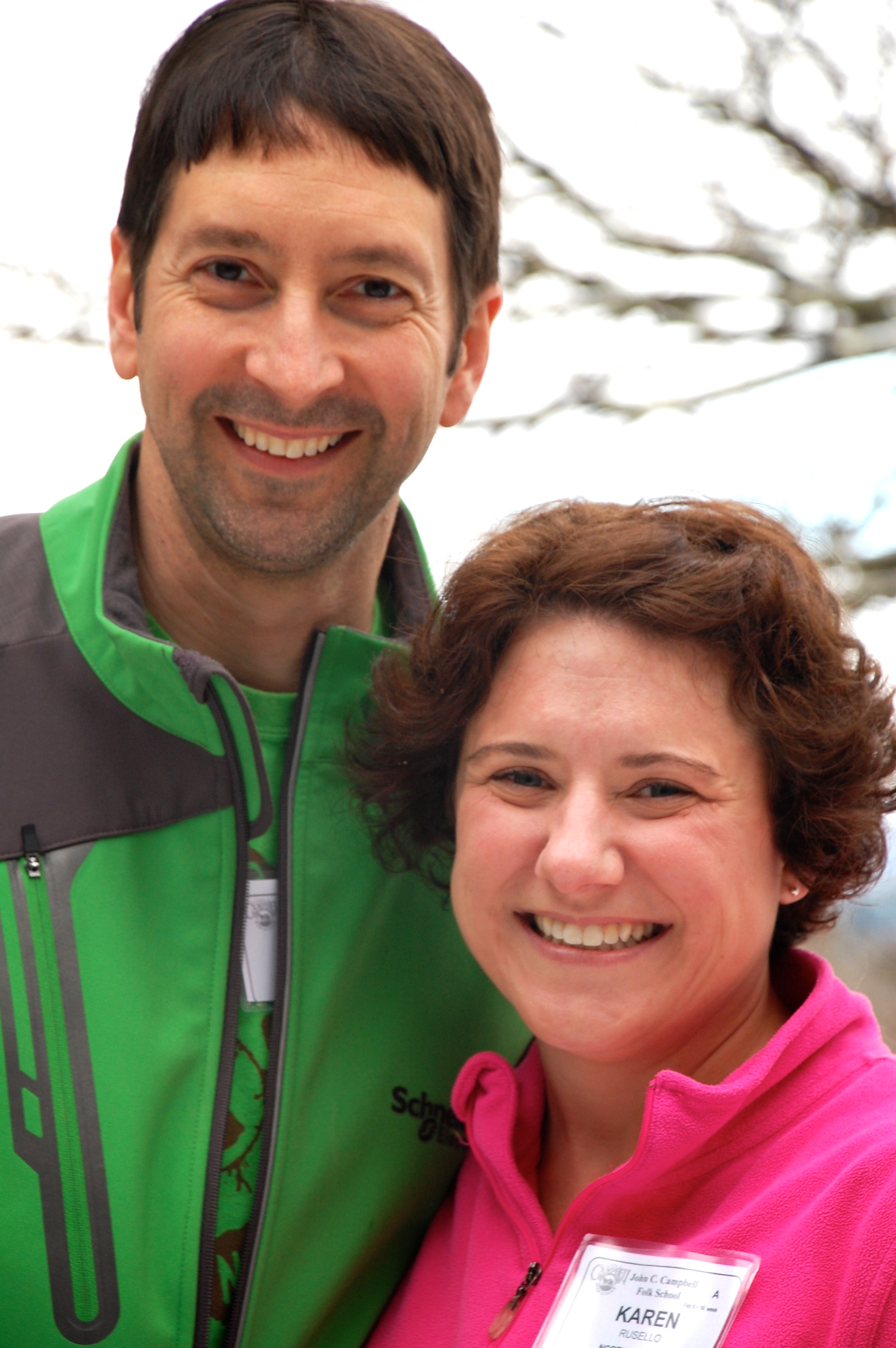 Wood turners and spinners make good sweethearts.[/caption]
Wood turners and spinners make good sweethearts.[/caption]
Karen is a second-time Folk School student who brought her husband Paul here for the first time. They did not pick this week intentionally for Valentine’s Day but are happy to be here to celebrate with the Folk School community. Karen and I are classmates in Martha Owen’s Sheep to Shawl spinning/dyeing class together, while Paul is over in the Woodturning class with Phil Colson.
Karen: I loved it here and knew he would love it too. So we looked through the catalog and found a week where we could be here and work on stuff together.
Leah: So between the two of you, who is craftier?
Paul: She is.
Karen: I might be more artistic, but Paul’s an engineer. He is into figuring out how stuff works and making beautiful things that function well.
Leah: What are you learning this week that you will take home with you?
Paul: In wood turning, you have to concentrate hard for short amounts of time and then stand back and watch to see the potential emerge. I think that’s something I am taking away from this week that applies in our life.
Karen: (laughs) So you concentrate on me for short periods of time??
Paul: (laughs) Yes – and then all the potential emerges.
Karen: I think the way we are spending time with each other this week is really reflective of how we want our lives to be, so it’s a good way to practice what to prioritize.
Leah: That’s beautiful you guys. However, I actually meant – what are you literally taking home for each other?!
Paul: I am making some spinning tools, and a bunch of stuff for our home. And I am working on a special thing that I haven’t told her about yet.
Karen: I am learning a bunch of techniques. I don’t know how much knitting I am going to get done, but eventually these techniques will turn into sweaters. Or socks.
AARP has written an article...


